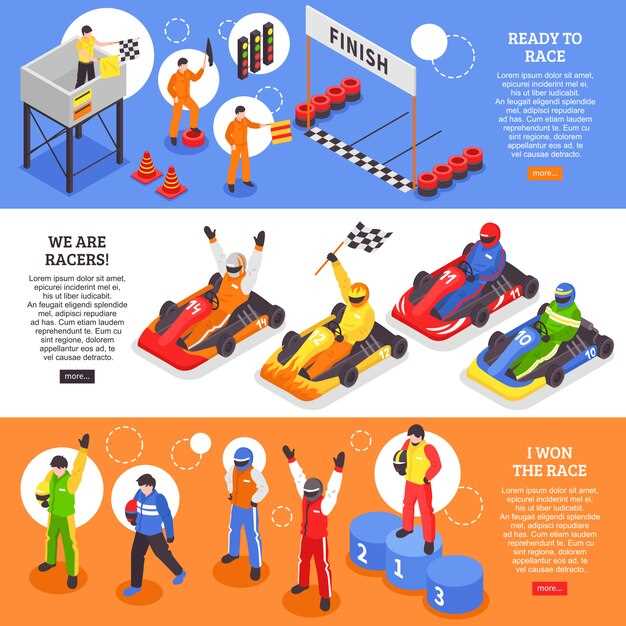
Getting involved in the world of racing can be a thrilling experience, especially when you choose to join an amateur club. Many enthusiasts share a passion for speed and competition, making it an excellent opportunity for both new and seasoned racers to connect. However, the entry process can be daunting without proper guidance. This step-by-step guide aims to help you navigate the path to becoming a member of an amateur racing league.
Before you dive into the tracks, it’s essential to understand what joining a racing club entails. Each league has its own set of rules, membership requirements, and entry fees. Familiarizing yourself with these aspects is crucial for a smooth transition into your new racing environment. In this guide, you will learn about prerequisites, the registration process, and tips for maximizing your experience within the amateur racing community.
By following this comprehensive roadmap, you’ll not only position yourself for success but also enrich your love for racing and camaraderie within the club. Whether you are looking to improve your skills, meet like-minded racers, or simply enjoy the adrenaline rush, this guide will help you lay a solid foundation for your racing journey.
Understanding the Requirements for Joining a Racing Club

Joining a racing club can be an exhilarating step for motorsports enthusiasts looking to enhance their skills and experience. However, each club may have specific requirements that prospective members should understand before applying.
First and foremost, age restrictions often apply. Most racing clubs require members to be at least 18 years old, but some may accept younger individuals with permission from guardians. Additionally, having a valid driver’s license is typically mandatory, as it ensures that participants have a basic understanding of driving laws and safety protocols.
Another crucial aspect to consider is the type of vehicle you plan to race. Clubs often have regulations regarding the cars eligible for their events. This may include specific makes and models, safety equipment, and necessary modifications. Ensure your vehicle meets the club’s standards to avoid any issues on race day.
In terms of safety, many clubs necessitate attendance at a safety briefing or training session. This is designed to familiarize new members with the rules of the track, emergency procedures, and the importance of equipment usage. Having proper safety gear, such as helmets and racing suits, is also often required.
A financial commitment is another essential factor. Joining a racing club may involve membership fees, costs associated with events, and potential expenses for vehicle maintenance and upgrades. It’s wise to review the financial obligations and determine your budget before proceeding.
Finally, enthusiasm for racing and a genuine willingness to learn are highly valued traits. Many clubs foster a community spirit that encourages camaraderie among members. Engaging with others who share similar passions can greatly enhance your experience in the motorsports scene.
Selecting the Right Amateur Racing League for Your Skills

Choosing the appropriate amateur racing league is crucial for your growth in motorsports. Each league has its unique focus, rules, and participant skill levels, making it essential to find one that aligns with your racing experience and aspirations.
Start by assessing your current skill level. If you are a beginner, look for leagues that cater to novice racers. Many clubs offer introductory programs that provide mentorship and structured guidance, ensuring a safe and supportive environment. As you gain experience, consider transitioning to a league that challenges you further.
Next, examine the types of racing offered by various clubs. Some leagues specialize in specific disciplines such as karting, sprint racing, or endurance racing, while others may host a mix of events. Aligning your interests with the league’s offerings will enhance your motivation and enjoyment in racing.
Another important factor is the league’s community and support network. A thriving amateur racing club often fosters camaraderie and shared learning experiences. Engaging with like-minded individuals can improve your skills and provide valuable insights into the racing world.
Lastly, consider the league’s reputation and the level of competitive spirit. Research past events and the performance of its members. A competitive environment can push you to improve, but it’s essential to ensure that the atmosphere remains positive and encouraging.
By carefully evaluating these elements, you can select an amateur racing league that not only matches your skills but also promotes your growth in motorsports and racing.
Preparing Your Vehicle and Gear for Club Racing Events
Getting ready for club racing requires careful attention to your vehicle and gear. Start with a thorough inspection of your vehicle to ensure it meets all safety and performance standards set by the racing league. Check tire conditions, brake functionality, and fluid levels, including oil, coolant, and brake fluid. Consider upgrading tires to sport or racing types for better grip on the track.
Next, focus on your vehicle’s weight distribution and balance. Removing unnecessary weight can enhance performance. Lightweight components, such as racing seats and panels, can be beneficial. Additionally, ensure that your suspension system is properly adjusted for racing conditions to improve handling.
Your gear is equally important. Invest in a high-quality helmet certified for racing to protect yourself during events. Choose racing gloves and a suit made from fire-resistant materials to comply with safety regulations. Don’t overlook the importance of appropriate footwear, as racing shoes should provide grip and support for optimal pedal control.
Finally, familiarize yourself with the rules and guidelines of the club you’re entering. This includes understanding technical specifications for your vehicle and required safety equipment. Proper preparation not only ensures compliance but also boosts your confidence on race day.
